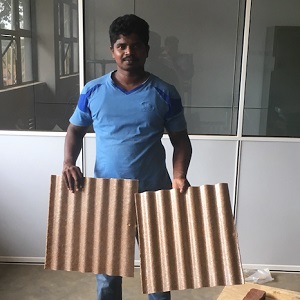
The Waste for Life is a project was initiated by Dr. Randika Jayasinghe together with the leadership of Profesor Caroline Baillie from the University of Western Australia. This was one of the excellent project which proven its outcome. This was initiated in August 2014. This was target to develop Community-based Waste Recycling Businesses, with particular focus on the progress in Northern Sri Lanka. It was excellent hard work of the team headed by Dr. Randika, Dr. Cynthujah and Mr Ashokcline Thayalan.
This project has develop the steps for roof sheet making process. The main portion of this project is to empower the community for showing up the business opportunity from waste materials for their living. Also it targeted to bring down the waste to as minimum as possible. The faculty of Engineering thanks the hard working team developing this through this Faculty of Engineering as the real services to the community and the country towards green production.
During the last week of June, the team were able to identify and streamline a manufacturing method for the production of the corrugated roof sheets. It is good for low cost building concept and replacing the Asbestos sheets for roofing. As the first step the team plan to replace the asbestos roof of a toilet block with the Rice Husk/Waste HDPE corrugated sheets, which was manufactured by the team. Few more tests are in progress on material properties such as Tensile Strength, Flexural Strength, and Strength under accelerated weathering etc. The details of the steps for tile making process is given below:
Required materials and equipment:
1) HDPE Plastic
2) Rice Husk
3) Hot Press Machine
4) Industrial sized shredder
5) Cold press
6) Corrugation Mould
7) Aluminium flat sheets and picture frame
8) Teflon
9) Stanley knives
10) Scales
The following will describe the process to make a 700g 450 x 450 mm Rice Husk/HDPE 20/80 Tile.
Step 1:
Calculate and weigh the required Rice Husk and HDPE. For a 700g 20:80 Rice husk:HDPE Tile, we need 140g RH and 560g HDPE


Step 2:
Arrange the Rice Husk on the HDPE in layers trying to get as even a spread as possible. Sandwich the arrangement between to layers of Teflon so as to prevent the melted plastic sticking to the Hot Press plates. The Teflon sheets are in turn placed between two flat aluminium sheets

Step 3:
Insert the aluminium sheets with the arrangement inside into the hot press pre-heated to 140 deg. Set the timer for 10 min and the pressure to 700 psi.
Once the timer sounds, withdraw the plates using heat resistant gloves and transfer into the cold press.

Step 4:
Leave in the cold press for a further 10 min before removing the “pancake” of RH and Plastic formed from within.


Step 5:
Shred the pancake in the shredder into little pellets.
The reason for this is to ensure homogeneity when made into a tile.

Step 6:
Wrap the pellets in another large HDPE layer on all sides before placing in an aluminium “picture frame”. Compact the pellets and spread out evenly before wrapping.
The reason for the outer membrane of HDPE is to ensure waterproofing in the tile.


Step 7:
Place the aluminium “picture frame” between two sheets of Teflon and put in the hot press again for 10 min at 140 C , 700 psi before inserting into the cold press, repeating the process to obtain the pancake.
Step 8:
Upon removing from the cold press, using a Stanley knife separate the tile from the frame.
Separate the flash from the tile.


Step 9:
Place the tile between two layers of Teflon and insert into the hot press for 5 minutes but do not apply any pressure by closing the hot press this time. This is purely to soften the tile.
Place the softened tile between two corrugated moulds and press in the cold press for 10 minutes.


Step 10:
Withdraw the tile from within the cold press!


Step 11:
Field testing in progress



